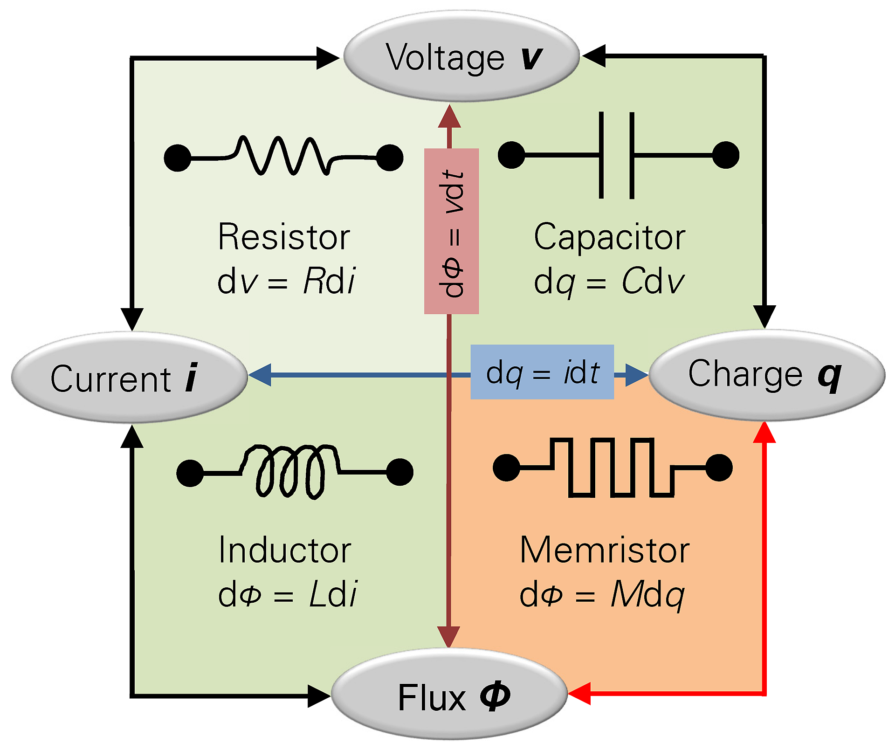What comes to mind when one thinks of physics and what comes to mind when one thinks of biology seem quite distinct. But over time, the two fields continue intersecting, especially as scientists try to replicate biological systems using electrical circuits. This is an enormous challenge because biologists first need to map and understand the original system, and physicists need to translate multilayered processes into a series of electrical impulses. However, a device made of metals called a memristor may be the key to efficient future biomimicry.
In 1971, Leon Chua, an electrical engineer at the University of California, Berkeley, published a paper called “The missing circuit element,” in which he suggested that besides the resistor, capacitor, and inductor, there should be a fourth component to the basic passive circuit. He noticed that despite there being an equation and passive circuit element connecting almost every combination of circuit variables, there wasn’t an equation nor element to relate charge and magnetic flux. Chua derived the missing equation to represent “memristance,” but he didn’t propose the possible physical qualities of a memristor. His paper was largely theoretical and served as an open-ended question to the rest of the physics community.
Thirty-seven years later in 2008, Stanley Williams, who completed his PhD in Physical Chemistry at UC Berkeley just seven years after Chua published his paper, answered the call in a paper titled “The missing memristor found.” His team at Texas A&M University created a combination of metals that could change between two states depending on which direction current was passed through it.
The part that was most exciting to fellow scientists was that if you switched the metal to a particular state and then turned off the circuit, the metal would “remember” which state it was in last when you turned it on again.
The part that was most exciting to fellow scientists was that if you switched the metal to a particular state and then turned off the circuit, the metal would “remember” which state it was in last when you turned it on again. Williams called one state ON and the other OFF because this is the binary system by which computers function: an ON (represented by 1) is an electrical impulse and an OFF (represented by 0) is the absence of it.
The combination of metals Wiliams built the memristor out of can be thought of as a sandwich with platinum as the bread and titanium dioxide (TiO2) in between. Essential to Williams’s memristor were two layers of TiO2 side-by-side inside the “sandwich”: one was normal and the other was oxygen-deficient. When a material is oxygen-deficient, some oxygen molecules are shot out of it, and the empty spots left behind are called oxygen vacancies. Positively-charged oxygen vacancies want to move toward a negative charge, and since currents are made up of negatively-charged electrons, the vacancies travel in the same direction as the electron flow.
If the current reaches the side with the oxygen-deficient TiO2 first as it goes through the memristor, then the oxygen vacancies push into the regular TiO2, following the flow of electrons. When they do this, they “convert” the section of normal TiO2 into oxygen-deficient TiO2. If the current goes the other way, then the oxygen vacancies crowd together at the edge of the TiO2, leaving the majority of the TiO2 oxygen-”sufficient.”
Changing how much of the total TiO2 is occupied by oxygen vacancies is how the state of the memristor can be varied. The total resistance of the memristor depends on if most of the TiO2 is oxygen-deficient or not. Normally, TiO2 has high resistance to electric current because it is an insulator, but oxygen-deficient TiO2 has low resistance. Williams called the low resistance state ON and the high resistance state OFF.
More recently, in January 2021, a group at the Institute of Materials Science of Barcelona created a memristor out of a modified combination of metals, but it holds memory by the same low-resistance/high-resistance principle. Incredibly, the unit they engineered can not only be switched between states by an electric current but by shining a light on it as well. Before this finding, memristors were exciting in the field of neuromorphic engineering, which aims to replicate nervous systems using circuits, but now they’re even more promising because memristors could be activated with light in the same way sensory neurons fire in response to stimuli. Not only are memristors useful for biomimicry but they could also be incorporated into modern technology like cell phones and laptops because of their energy efficiency and compact size. Chua’s ambitious proposal from 50 years ago that led to memristors may soon have a wide impact from carrying improved devices around in our pockets to making artificial brains.
Image Source: Wikimedia Commons





